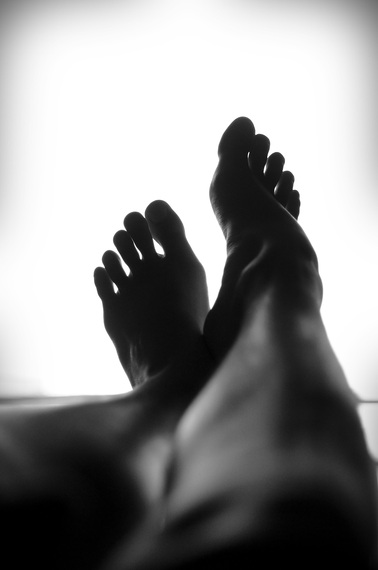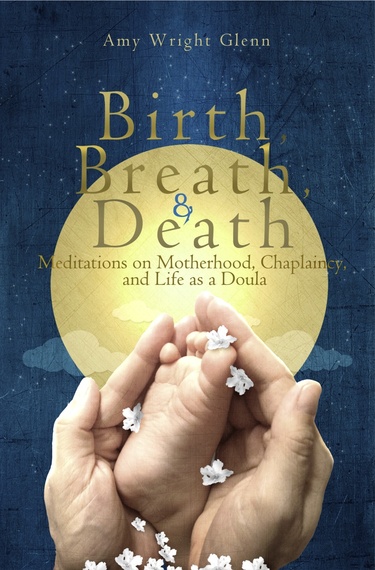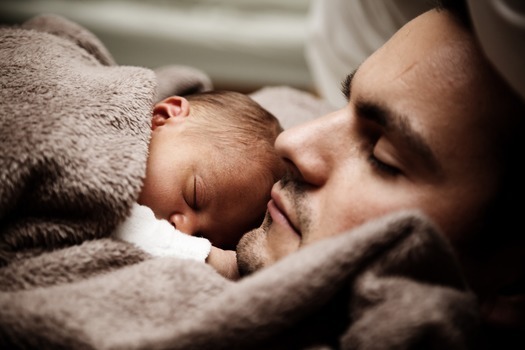"Nothing in life is to be feared, it is only to be understood. Now is the time to understand more, so that we may fear less." -Marie Curie
Is there something similar we have to consider when caring for others as they birth and as they die?
As a birth companion, I often witness the relationship between care and fear. How we approach caring for others during anxious and intense moments is critical. In the case of childbirth, we are beginning to understand how fear can have direct physiological consequences. What Michel Odent refers to as physiological fear at the end of labor can facilitate birth. Concern from external information and expectations, on the other hand, can slow down, intensify, or complicate a birth.
STORIES & FEAR
Environmental fear is transported by way of our stories. Stories reflect our worldview and expectations. Stories mirror our mindset. Stories reproduce our experiences. Our stories are how we experience life. Personal stories, then, also guide our care for others. During pregnancy and childbirth, it becomes pretty obvious that even without any actual personal memory of this experience, women come full of stories and expectations that eventually shape their experience. For better or worse, the stories that caregivers bring to this experience also dictate their responses. This shapes the outcome and influences new stories. Stories are our perspective and can become our experience.
The correlation between stories, fear, and care has brought my attention to the global narrative of how we as midwives, doctors, nurses, and doulas care for women and their partners during pregnancy and childbirth. I am particularly fascinated by the many ways we see and represent fear. I'm interested in what information and narratives impact our fears of birth, and what helps us work through or overcome fear.
BIRTH & DEATH
In a treasured ethnography of North American midwives by Penfield Chester, midwife Ina May Gaskin subtly parallels her experience attending homebirths with sitting at the bedside of her dying adult daughter. This, for her, was a very intimate and peaceful transition that belonged in the most intimate space: their home. After this experience she, her husband, and their community built houses on The Farm (their famous commune) specifically for individuals wishing to spend the last days of their lives in the company of others - and in serenity. They are well-known for also building spaces for birthing women wishing to give birth at home, while supported by the acclaimed midwifery community there. For me, homebirth was a pretty comfortable concept, having experienced it several times. But, after coming across this reference to Ina May Gaskin's experience with her daughter, I was given a glimpse of the acceptance and seeming lack of fear that could also be possible when dying.
This account expanded my associations with the end of life. My imagery of dying shifted from one of resistance, loneliness, exposure, and machinery to include intimacy, familiarity, and acceptance. This account connected me to that moment I learned that childbirth could also safely occur in any environment.
LESSONS ON LABORING, LOVING & LEAVING
Until I came into contact with Amy Wright Glenn, founder of the Institute for the Study of Birth, Breath and Death, I had never seen these two transitions - birth and death - extensively explored in correlation, particularly through the lens of caregiving. Glenn is also the author of the beautifully written book Birth, Breath, and Death: Meditations on Motherhood, Chaplaincy, and Life as a Doula. In her book, Glenn poetically addresses these topics through her own personal stories. She tells of holding space as a birth companion (doula), and at the end of life, in her role as a hospital chaplain for dying patients. In doing this work, she relies on practices of awareness - what Amy refers to as breath - which she evolves over many years. These practices shaped her own stories and perspective of life experience. And by deduction, they shape the way she approaches caring for others during childbirth or as they pass.
This work is very useful. It helps us see how the deep impressions left on us by life, do return to us as we craft our responses to every new situation we encounter. The more we do to locate the lessons and beauty in every event (even the tough ones), the easier it is for us to embrace challenges with equanimity. The stories in this book are a good example of this. They trace Glenn's own quandaries about belief and belonging from an early age. We witness her devout connection to her religious community as a child and teenager. This was in juxtaposition to her fascination with theories of evolution and openness to scholarly learning found in secular schools. In this context, she reveals the confusion of her mother's developing mental illness with more extreme interpretations of her family's religion. Her mother's fears found fertile ground in the religion itself. In her questioning, Glenn finds inevitable cause to abandon both Mormonism and her mother's overwhelming fears of life and life's end.
In these stories we see how someone is able to develop a relationship with an overarching fixation of fear and navigate her way through it. Amy Glenn's open heart is evident in her writing. This is where I realized her writing serves caregivers, who deal with the same issues she does in her work.
In my focus as a birth doula, the level of cultivated compassion and equanimity I find in Amy's narrative is something I believe is important to rely on as we support pregnant and birthing women through this transition. Especially because this experience is very often layered with anxieties fed by stories that leave a penetrating impression.
Her book Birth, Breath, and Death chronicles the births of women she accompanied as a doula. After having attended the births of many other women, she eventually decides to become a mother herself and reflects on the intense and transformative birth of her own son. Her own birth experience gives new shape to her evolving understanding of doula care. Her hospital doula work, meditation practice, and long-term engagement in theology points her to hospital chaplaincy training. As a hospital chaplain, Amy witnesses the serenity that can surround death. But she also has to find her own capacity to recover from the harsh realities of violence as she is called to oversee the cold body of a murder victim.
The nature of this birth and end of life work puts caregivers in direct contact with the relatives and families of those in transition. These occasions are celebrated and mourned in very different ways across cultures. When fear and uncertainty is present, forms of prayer is something that many call on for relief. It is part of their story. As a caregiver for the dying, prayer and meditation was also part of Glenn's story. Something she relied on for clarity for herself. How do we transfer our everyday tools for understanding and for working with fear onto those we care for? Or do we?
Amy Glenn's chaplaincy director wisely reminded the group of hospital chaplains who abided by an evangelical faith that "the hospital isn't a place for Christian chaplains to teach the word of Christ, it is a place for Christian chaplains to embody the Word. He advised [them] to set aside formulaic religious approaches and affirm love's essence."
In the title of her book alone, Amy Glenn leads us to wonder whether there is something that necessarily binds all these experiences. Is there something similar we have to consider when caring for others as they birth and as they die? In my research and practice as a birth doula, I encounter similar questions. However, in the case of childbirth, sharing basic knowledge about the physiological functions of the human body can serve to empower women. It can build faith and trust that they are capable of birthing on their own. It can release fear and direct them to rely on their own innate ways to move through the experience. In an age of too much information, however, providing this knowledge without slipping into dogmas or agendas is a careful art.
THE SPIRIT TO SERVE
Dr. Michel Odent, obstetrician and a founder of the organization Doula UK, once shared in a conversation something that parallels the chaplain's advice. He emphasized that in expanding the doula role in childbirth, it is critical to remember that more important than the collection of skills and certifications, is keeping intact the essence of the doula herself. The value of this role is in a person's ability to be compassionate, to empathize, and connect to the birthing woman's story and identity. The doula is responsive and holds space for a laboring woman - acting in accordance to what feels safe for a birthing woman. This approach has direct repercussions on a woman's physiological functions. With the expansion of doula practice and studies demonstrating the benefits of continual care on birth outcomes, the quality of support must be noted.
There are many ways to approach birth companionship. Having witnessed the primal procession of undisturbed birth, and the hurried and perplexing nature of emergency caesarians, it's clear that portions of our own memory (and identity) as caregivers emerge in the moment to inform how we care for others. As caregivers, each of our own stories (and knowledge) gives texture and guidance to the way we care for others. Birth, Breath, and Death is important because it is a narrative that offers companionship to caregivers in our attempts to address our own questions about empathy, compassion, non-judgment, and caring for others during intense and transformative moments. It offers a space to debrief and reflect. It touches on ethics and metaphysics with some depth. The fascinating work and protocols of hospital chaplains becomes very familiar.
The book only briefly grapples with some of the expanding questions and quandaries that emerge from doula, midwifery, and hospital birth practice and protocols. In service to this need, however, the book is a personal contemplation. One that invites important discussion and emerging thought on these important subjects that aren't much discussed outside of those who do the work directly.
OUR STORIES MATTERS
Like Amy Glenn, the more time I've spent in the company of pregnant women and their partners, studying ethnographies of midwives, and hearing freshly trained doctors' accounts of delivery clinics in various parts of the world, the more I've come to understand that our collective birth narrative is by no means a universal one.
Many of the most common accounts of birth instill a sense of anxiety in the thickest skinned of us. Every experience needs to be embraced and understood. Everyone needs a space to share their personal experience without feeling betrayed. Nonetheless the balance of stories have been overwhelmingly tilted toward troubling accounts of childbirth. This without taking into greater account the consequence of bad practices over time.
On the other hand, there are growing collections of deeply positive narratives of birth. Births in the security of our homes. Even necessary caesarian births that were guided with care, consent, a sense of control. Research and careful observation have helped us understand why some of our common practices result in complicated outcomes. These help us develop new and improved practices and stories.
COMPASSION IN THE FACE OF INGRAINED STORIES
Stories can reproduce physical experiences that resemble themselves. When worrying birth narratives run so deep in our society, information (or understanding) alone does not have the capacity to eradicate fear. Protective and compassionate care along with guided practices are needed to translate information about how a woman's body usually works during birth into new stories.
For birthing women, these new stories provide a sense of empowerment in any situation. They include a wider spectrum of possibilities. Birth is an involuntary process, however we sometimes need to be prepared with regular guided practices found in methods like Hypnobirthing or the Bonapace Method to help our minds remember the state of release.
In a normal childbirth situation, these practices can help us recall this sense of ease and relaxation even in the most intense moments. These practices use tools like positive language, visualization, meditation, yoga poses, emotional freedom technique (EFT), and explanations of childbirth physiology.
This kind of compassionate care that considers the impact of the stories we tell ourselves, met with sound information, really matters. The range of birth narratives don't only reflect negative side effects of interventions. They also resemble accounts of the normal intense emotional and physical challenge that childbirth can be for many. The challenges of a normal birth can surely play out as extremely fulfilling experiences, but may not translate in an outsiders reading of the experience. This makes it more difficult to explain or prepare women for the things that worry us about childbirth.
Unfortunately, the differentiation between challenging experiences that result from disturbing the birth process or from a genuine complication is difficult to define. There is still so much we have yet to understand about the physiology of childbirth itself. As we continue to learn more, our care practices and stories continue to improve.
IN NEED OF NEW METAPHORS
Because it is an unparalleled event in the life of a woman, we sometimes have to talk about birth metaphorically. Birth is hiking a mountain with a sometimes unpredictable weather forecast. It can be a great challenge. It can be filled with moments of inspiration. It can be rewarding. It can be triumphant. It can change our character. It can require motivation. It can be a solo expedition. It can be intensely painful. We can enter it with a kit to help us in case anything deviates from the norm. In severe cases, it can require a rescue operation. In most cases, with the right environmental conditions, mindset, and preparation, we have everything we need to successfully go through the experience. And of course, birth has other metaphors.
Stories of childbirth are so profound. They impact our expectation of a physical experience. This also impacts our actual physical experience.
This mountain climbing metaphor gives way to the obvious role of caregivers. Had this mountain climber a coach, the coach would expect this experience to be challenging, but they would also have experience navigating the terrain. They would provide preparatory guidance. Awareness of the climber's capabilities would have been made obvious. They would understand the necessary first aid techniques and when more critical aid is required. They would only use these aids when necessary. They would be aware of the transformational character of the trek. They would be equipped with knowledge of what is normal physiological responses to the challenge. They would have an overview of optimal nutrition and postures for the experience. Protecting the mindset of the climber would be prioritized. They would read signs of the climber reaching her limits. They would empathize. They would be alert to deviations from the norm. They would know when to interfere. They would be at ease with simply witnessing.
Back to Marie Curie's statement. My response would be something like: Fear is dissolved under the auspices of awe, knowledge, and everyday practices of compassionate care.
In a conversation with Susan Fauman, founder of Food, Sleep, and Sex, about her work as a hospice volunteer for two years, she shared a theory she had been introduced to from a colleague who had been serving as an end of life companion for many years. At the beginning and end of each weekly shift, the group of hospice volunteers would meet to debrief and discuss what had come up for them while sitting with the dying. Her colleague described the body of a dying person by using a metaphor of a ball of wax with contours and grooves.
As the person approaches death the smooth outermost surface started to detach and fall away. What is left are impressions of the most deeply ingrained memories of that person's life. These are the contours and grooves. Once the surface grooves were worn away, only the deeper lines remained. He described commonly witnessing the dying as they retreat into anger or deeper sadness. Then, he described others who left with overwhelming expressions of love. His goal in sitting with the dying, Susan explains, was to deepen the "love groove". Susan attributes these contours to everyday practices that deepen memory of wellbeing. Practices like yoga and meditation.
In our everyday life leading up to these pivotal transitions - like childbirth or dying - these practices provide us with guidance and a nuanced understanding of the content of what we may experience. Our personal stories are infused with the charge of these everyday practices. These practices contain information. These practices can introduce us to sensations that connect us to something universal. They do not necessarily determine the outcomes of our transitions. They create familiarity with what makes us feel wellbeing in every moment. They bring us everyday experiences of love. Of appreciation. Of presence.
In Birth, Breath, and Death, Amy Glenn beautifully refers to this as being in the realm of breath. This is our experience of everyday practices. For her breath is present in everything between the moment a child comes through it's mother until the moment we die. She points to philosopher Ken Wilber's reference to deep structures (structures that are universally meaningful). They describe practices - like yoga, prayer, meditation - that have a noticeable impact on our everyday sense of wellbeing. They are practices that cultivate these contours of love and release that Susan Fauman describes.
Now we return again to our question of fear and understanding. Part of compassionate care is providing information, guidance, and allowing others to rely on their own tools for movement through these transitions. This familiarity can dissolve fear.
If there is indeed something (i.e. knowledge) to be understood in approaching our fears at the end of life, particularly about cultivating "love grooves" through everyday stories and compassionate care, perhaps Amy Glenn's glance toward the deep structures mentioned in the work of Ken Wilber can guide us again.
Wilber says "[In types of meditation] there are important variations, but there are also many, many important similarities, so much so that this deeply suggests some real and universal realities are involved here. The general stages of meditation, the types of awareness at each stage, and the general characteristics of each stage and the type of "knowledge" it delivers makes this entire area one to be taken with utmost seriousness. Meditation in general is delivering profoundly significant information about the human condition, the universe, and both relative and ultimate Truth."
This understanding may be a suggestion that meditation, described in many different cultures and contexts, has the universal power to help us look beyond death itself. And it moves us beyond our fears of it.
THE LESSONS THAT SURROUND US
This conversation has really expanded my awareness of everyday information that feeds into our general understanding of birth and (now) death. In the middle of writing this piece, I attended a birth that gave me new insights into how to provide support. How to provide care in such a way that we all could still deeply appreciate what is special even in the unexpected or difficult aspects of birthing.
In the days before I also stumbled across a boutique coffee shop with a collection of Lapham's Quarterly magazine. I immediately spotted the Death issue. It opens up with a proverbial statement from Sima Qian, c. 98 BC, who was known as the Grand Historian for documenting two thousand years of Chinese history. It read: "A man only has one death. That death may be as weighty as Mount Tai or it may be as light as a goose feather. It all depends upon the way he uses it."
Again, this reference suggests that universal theme that there are many ways to approach potentially frightening transitions. There is a universality in the understanding revealed between this ancient observation and the contemporary one of a long term hospice caregiver.
When Amy Wright Glenn first introduced me to her work, I was grappling with understanding the variations and different definitions, titles, and implications of what it means to be a birth companion. I have tried to balance sharing my own personal stories of blissful birth, with stories of complications and the complex state of obstetrical practices globally. I knew that no matter what the experience looks like, it creates a shift in perspective for anyone who witnesses it. It is even sacred in its intensity or serenity. The word doula in Greek means servant or slave. Greek friends often find this jarring, so the title of this role alone opens up robust questioning. When I came to understand Amy Glenn's efforts to interrelate professional birth companionship with end of life chaplaincy, many important connections and paradoxes became apparent.
Birth, Breath, and Death stirs up some important questioning. It does tremendous service to guiding us to pinpoint what matters in serving others. It challenged me to reconsider what understanding is required to guide and care with empathy. Fear dwells around transition. It belongs to the unknown. Our stories and everyday practices can carry on those fears or they can help us release them.
As Amy Glenn deduces from her hospital chaplaincy training, we all can "Listen more, care deeply, and soften around the hard edges of pain".
Camalo Gaskin writes about childbirth companionship, contemporary motherhood and is founder of birthtobirth.com







